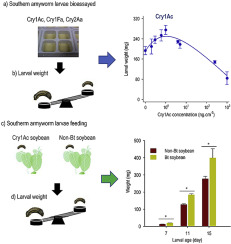当前位置:
X-MOL 学术
›
Crop Prot.
›
论文详情
Our official English website, www.x-mol.net, welcomes your feedback! (Note: you will need to create a separate account there.)
Bt-toxin susceptibility and hormesis-like response in the invasive southern armyworm (Spodoptera eridania)
Crop Protection ( IF 2.8 ) Pub Date : 2020-06-01 , DOI: 10.1016/j.cropro.2020.105129 Marcelo M. Rabelo , João Marcus L. Matos , Oscar F. Santos-Amaya , Josélia C. França , Jaciara Gonçalves , Silvana V. Paula-Moraes , Raul Narciso C. Guedes , Eliseu José G. Pereira
Crop Protection ( IF 2.8 ) Pub Date : 2020-06-01 , DOI: 10.1016/j.cropro.2020.105129 Marcelo M. Rabelo , João Marcus L. Matos , Oscar F. Santos-Amaya , Josélia C. França , Jaciara Gonçalves , Silvana V. Paula-Moraes , Raul Narciso C. Guedes , Eliseu José G. Pereira

|
Abstract Bacillus thuringiensis (Bt) varieties of soybean and cotton have been widely adopted in South America, but defoliation by the southern armyworm Spodoptera eridania (Lepidoptera: Noctuidae) has increased in these crops. This issue may be linked to the low inherent susceptibility of the larvae to some Bt toxins. However, this hypothesis was not yet tested, nor was the potential sublethal effects of the toxins on larval development of southern armyworm. Here we determined the response of southern armyworm larvae exposed to Bt toxins representative of those used in soybean and cotton cultivars. In concentration-response bioassays, whereas a low median lethal concentration (LC50) value was found for Cry2Aa (11 ng/cm2), higher LC50 values were found for Cry1F (>3000 ng/cm2) and Cry1Ac (>10000 ng/cm2). Larval growth of the southern armyworm showed a hormesis-like response when the larvae were reared on artificial diet containing increasing Cry1Ac concentrations. Such enhanced larval growth was also observed when fresh foliage of Cry1Ac soybean or its lyophilized tissue in an artificial diet were fed to the larvae. Although the foliage of the dual-toxin Bt cotton producing Cry1Ac + Cry2Ab killed all larvae, its lyophilized leaf tissue caused no significant larval mortality when diluted 25 times. These results indicate that southern armyworm larvae have low inherent susceptibility to Cry1Ac and Cry1F toxins, while the Cry1Ac Bt toxin can enhance its larval growth. In addition, Cry1Ac + Cry2Ab Bt cotton may not meet the high-dose condition for the southern armyworm. These findings have important implications for pest management of the southern armyworm, which is discussed.
中文翻译:

入侵性南方粘虫(Spodoptera eridania)中的 Bt 毒素敏感性和类刺激反应
摘要 苏云金芽孢杆菌 (Bt) 大豆和棉花品种在南美洲已被广泛采用,但南方粘虫 Spodoptera eridania (Lepidoptera: Noctuidae) 的落叶在这些作物中有所增加。这个问题可能与幼虫对某些 Bt 毒素的固有敏感性低有关。然而,这一假设尚未得到验证,毒素对南方粘虫幼虫发育的潜在亚致死影响也未得到验证。在这里,我们确定了南方粘虫幼虫对 Bt 毒素的反应,这些毒素代表大豆和棉花品种中使用的那些毒素。在浓度反应生物测定中,Cry2Aa (11 ng/cm2) 的中位致死浓度 (LC50) 值较低,而 Cry1F (>3000 ng/cm2) 和 Cry1Ac (>10000 ng/cm2) 的 LC50 值较高. 当用含有增加的 Cry1Ac 浓度的人工饲料饲养幼虫时,南方粘虫的幼虫生长表现出类似兴奋剂的反应。当将人工饲料中的 Cry1Ac 大豆的新鲜叶子或其冻干组织喂给幼虫时,也观察到了这种增强的幼虫生长。尽管产生 Cry1Ac + Cry2Ab 的双毒素 Bt 棉花的叶子杀死了所有幼虫,但其冻干的叶组织在稀释 25 倍时不会导致显着的幼虫死亡。这些结果表明南方粘虫幼虫对Cry1Ac 和Cry1F 毒素的固有敏感性较低,而Cry1Ac Bt 毒素可以促进其幼虫的生长。另外,Cry1Ac+Cry2Ab Bt棉可能不符合南方粘虫的高剂量条件。
更新日期:2020-06-01
中文翻译:

入侵性南方粘虫(Spodoptera eridania)中的 Bt 毒素敏感性和类刺激反应
摘要 苏云金芽孢杆菌 (Bt) 大豆和棉花品种在南美洲已被广泛采用,但南方粘虫 Spodoptera eridania (Lepidoptera: Noctuidae) 的落叶在这些作物中有所增加。这个问题可能与幼虫对某些 Bt 毒素的固有敏感性低有关。然而,这一假设尚未得到验证,毒素对南方粘虫幼虫发育的潜在亚致死影响也未得到验证。在这里,我们确定了南方粘虫幼虫对 Bt 毒素的反应,这些毒素代表大豆和棉花品种中使用的那些毒素。在浓度反应生物测定中,Cry2Aa (11 ng/cm2) 的中位致死浓度 (LC50) 值较低,而 Cry1F (>3000 ng/cm2) 和 Cry1Ac (>10000 ng/cm2) 的 LC50 值较高. 当用含有增加的 Cry1Ac 浓度的人工饲料饲养幼虫时,南方粘虫的幼虫生长表现出类似兴奋剂的反应。当将人工饲料中的 Cry1Ac 大豆的新鲜叶子或其冻干组织喂给幼虫时,也观察到了这种增强的幼虫生长。尽管产生 Cry1Ac + Cry2Ab 的双毒素 Bt 棉花的叶子杀死了所有幼虫,但其冻干的叶组织在稀释 25 倍时不会导致显着的幼虫死亡。这些结果表明南方粘虫幼虫对Cry1Ac 和Cry1F 毒素的固有敏感性较低,而Cry1Ac Bt 毒素可以促进其幼虫的生长。另外,Cry1Ac+Cry2Ab Bt棉可能不符合南方粘虫的高剂量条件。

























 京公网安备 11010802027423号
京公网安备 11010802027423号